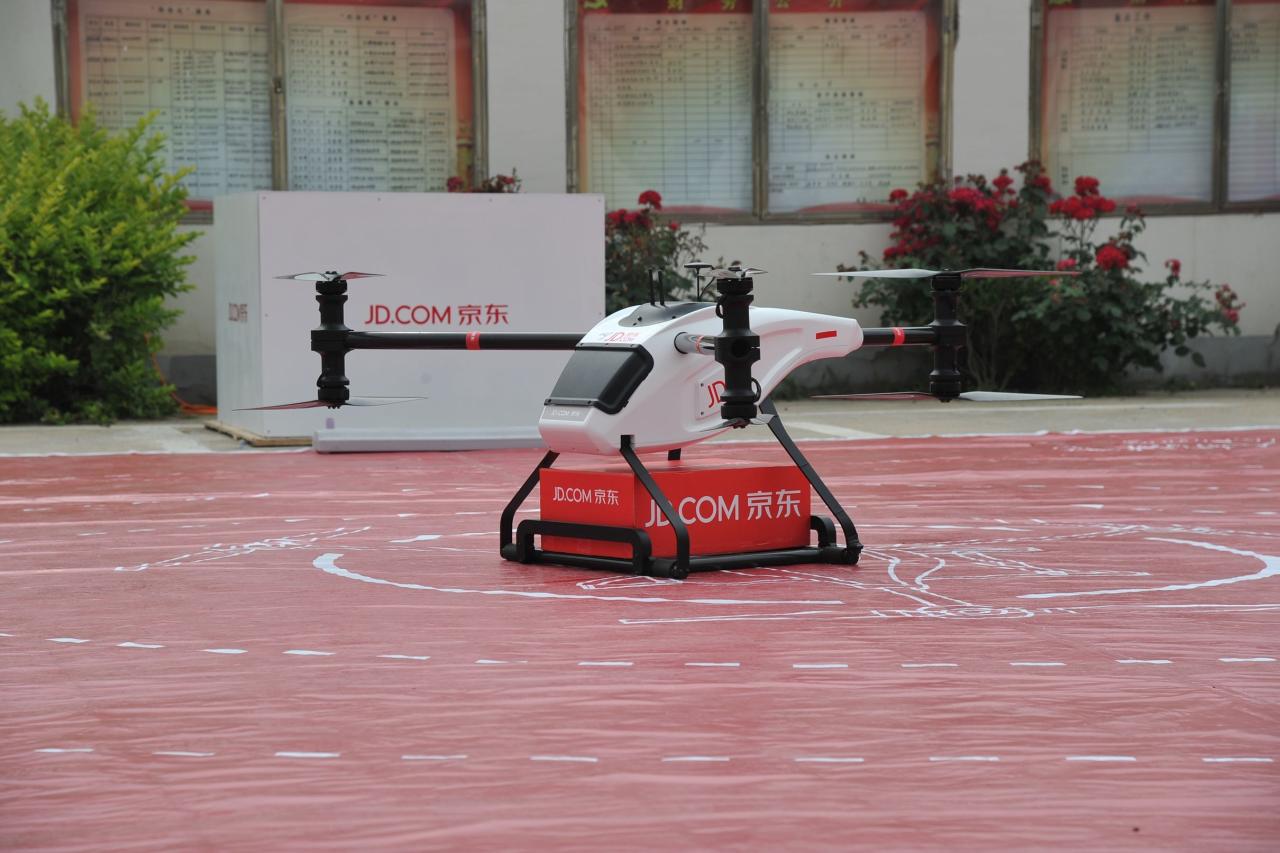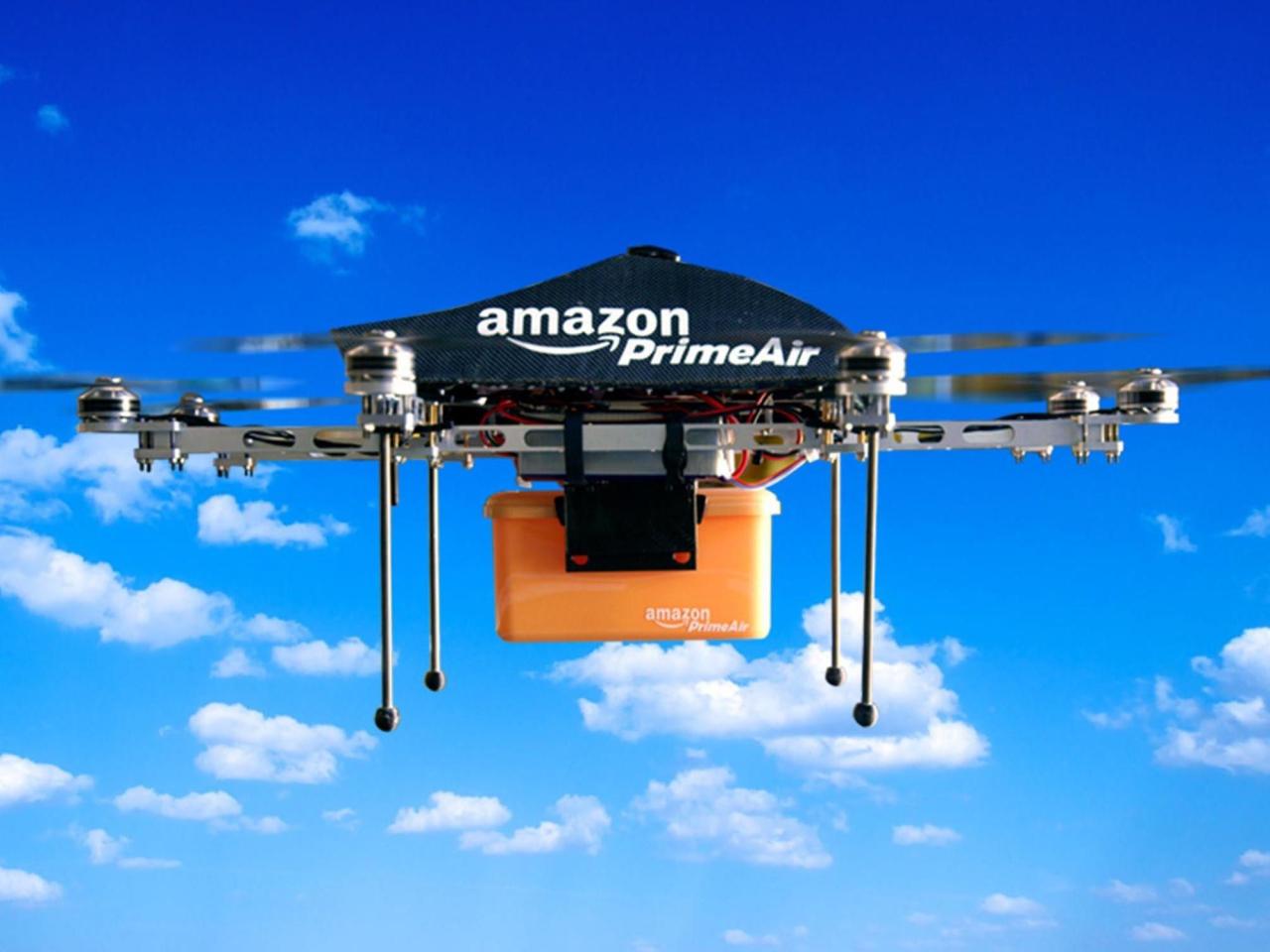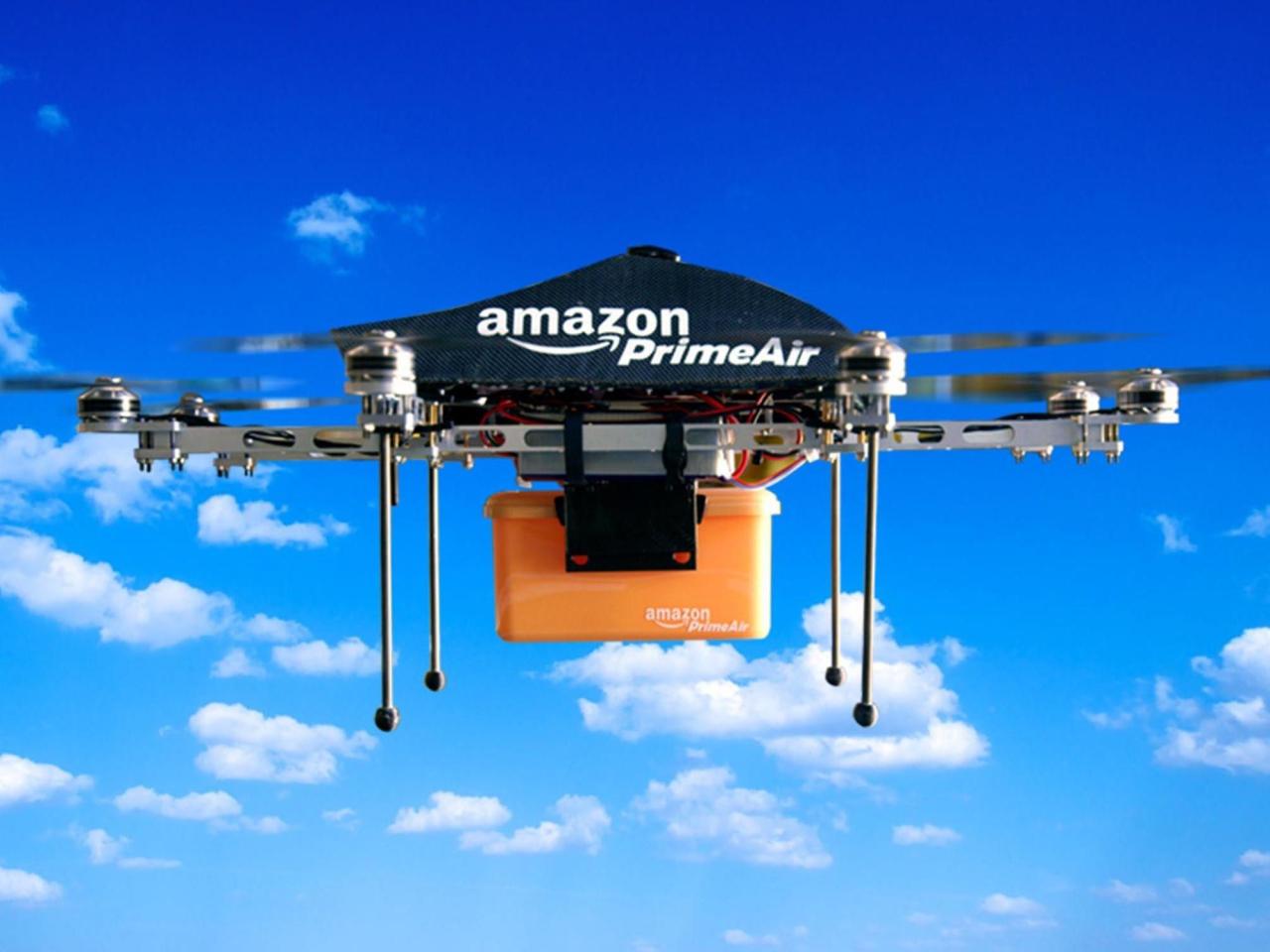Amazon drone delivery locations are rapidly expanding, transforming how we receive packages. This exploration delves into the current state of Amazon’s drone delivery program, examining the factors influencing location selection, the technology powering these deliveries, and the economic and social impacts on communities. We’ll also look ahead to the future of this innovative delivery system.
From the logistical challenges of urban vs. rural deployment to the technological advancements in drone navigation and safety protocols, we’ll cover the key aspects shaping the landscape of Amazon’s drone delivery network. We’ll analyze the regulatory hurdles, weather considerations, and the potential for job creation and faster delivery times. Ultimately, we aim to provide a comprehensive overview of this evolving technology and its implications.
Current Amazon Drone Delivery Program Status

Amazon’s drone delivery program, officially known as Amazon Prime Air, is steadily expanding its reach and capabilities, though it’s still in a relatively early stage of development compared to its broader e-commerce operations. While not yet a ubiquitous service, it represents a significant investment in future delivery solutions.Amazon Prime Air currently operates within a limited geographical scope. The service isn’t available nationwide, nor even statewide in many areas.
The company focuses on deploying its drone delivery infrastructure in carefully selected locations that offer a combination of favorable regulatory environments, suitable terrain, and sufficient customer density to justify the operational costs.
Geographical Scope of Amazon Drone Delivery
Amazon Prime Air’s drone delivery service is currently limited to select areas in the United States. These areas are typically smaller towns and suburban communities, chosen for their relatively flat terrain and less congested airspace. The exact locations are subject to change as Amazon expands and refines its operations. Unlike traditional ground delivery, which covers vast swathes of the country, drone delivery is still confined to these smaller, more manageable operational zones.
This strategic approach allows Amazon to test and refine its technology and logistics in controlled environments before broader deployment.
Eligible Package Types for Drone Delivery
Not all Amazon packages are eligible for drone delivery. Currently, the program focuses on smaller, lighter packages that can be safely and efficiently transported by the drones. This typically includes everyday items such as books, small electronics, and household goods. Larger, heavier, or fragile items are excluded due to limitations in the drones’ carrying capacity and the need to ensure safe delivery.
Amazon’s expanding drone delivery locations are pretty cool, right? But remember safety’s key; check out this article about the orlando drone show accident to see how things can go wrong. Understanding incidents like that helps ensure future drone deliveries – both Amazon’s and others – operate smoothly and safely.
The program’s limitations on package size and weight are continually being evaluated and adjusted as drone technology improves. Amazon prioritizes items that are highly suitable for rapid drone delivery to maximize the benefits of this innovative delivery method.
Infrastructure Requirements for Amazon Drone Delivery Locations
Establishing a drone delivery location requires careful planning and substantial infrastructure. Amazon needs secure launch and landing sites with adequate space for drone operations. These sites must be strategically located to ensure efficient delivery routes and minimize flight times. Furthermore, reliable communication networks are essential for real-time drone monitoring and control. The airspace above the delivery area needs to be assessed for safety and potential hazards, requiring coordination with relevant aviation authorities.
Finally, a robust logistics system is needed to manage the flow of packages to and from the drone delivery stations. These factors contribute to the selective nature of locations currently utilized for Amazon Prime Air.
Timeline of Amazon Prime Air Expansion
Amazon first announced its Prime Air drone delivery program in 2013. Initial testing and development phases followed, with limited public trials conducted in various locations. The program experienced gradual expansion, adding new delivery zones over time. The pace of expansion has been measured, reflecting the complexities of regulatory approvals, technological advancements, and operational considerations. While precise dates for future expansion are not publicly available, the trend indicates a continued, albeit cautious, increase in the program’s geographical reach.
Amazon is focused on iterative improvements and strategic expansion rather than rapid, widespread deployment.
Factors Influencing Location Selection

Choosing locations for Amazon’s drone delivery program involves a complex interplay of logistical, regulatory, and environmental considerations. Successful implementation requires careful evaluation of several key factors to ensure efficient and safe operations. The ideal location balances the needs of the business with the realities of drone technology and airspace management.
Several key logistical factors are paramount in determining suitable drone delivery locations. Population density is a major consideration, as higher population areas offer a larger customer base but also present challenges related to airspace congestion and potential safety risks. Existing infrastructure, including reliable internet connectivity for drone control and monitoring, is crucial. The availability of suitable takeoff and landing zones, ideally with minimal obstacles and ample space, is also vital.
Furthermore, the presence of established transportation networks for the delivery of packages to drone hubs significantly affects operational efficiency.
Urban versus Suburban/Rural Location Feasibility
Urban areas, while offering a large customer base, pose significant challenges for drone delivery. High population density leads to increased airspace complexity, requiring sophisticated flight management systems and adherence to strict regulations. Finding suitable takeoff and landing zones in densely packed urban environments can also be difficult. In contrast, suburban and rural areas generally offer more open airspace and easier access to landing zones.
However, the lower population density means a smaller customer base, potentially making drone delivery less economically viable in these locations. Amazon’s approach likely involves a hybrid model, focusing initially on suburban areas with growing populations and gradually expanding into more challenging urban environments as technology and regulations evolve. For example, a suburban area with a planned community and ample green spaces might be more suitable for initial deployment than a dense downtown core.
The Role of Regulatory Approvals
Regulatory approvals are absolutely essential for establishing drone delivery operations. Federal Aviation Administration (FAA) regulations concerning airspace usage, drone operation, and safety protocols must be meticulously followed. Securing the necessary permits and approvals can be a lengthy and complex process, significantly impacting the timeline for launching operations in a given location. The level of regulatory scrutiny varies depending on factors such as the density of the airspace, the proximity to airports, and the type of drone being used.
Locations that can demonstrate a robust safety plan and comply with all applicable regulations are more likely to be approved for drone delivery operations. For instance, a location near a major airport would face more stringent regulatory hurdles than one in a remote area with minimal air traffic.
The Impact of Weather Conditions, Amazon drone delivery locations
Weather conditions significantly impact the feasibility of drone delivery operations. Adverse weather, such as strong winds, heavy rain, snow, or fog, can ground drones, leading to delays and disruptions in service. Locations with consistently favorable weather patterns are therefore preferred. However, even in areas with generally good weather, contingency plans must be in place to handle unexpected weather events.
Real-time weather monitoring and robust risk assessment are crucial for maintaining operational efficiency and ensuring the safety of both drones and people on the ground. For example, a location with a high incidence of thunderstorms might require more sophisticated weather forecasting and backup systems than a location with consistently sunny skies.
Technological Aspects of Drone Delivery Locations: Amazon Drone Delivery Locations
Amazon’s drone delivery program relies on a sophisticated network of technologies to ensure safe and efficient package delivery. This involves advanced navigation systems, robust safety protocols, and reliable communication infrastructure, all working in concert to make drone deliveries a reality. Let’s explore the key technological components.
Drone Navigation and Package Delivery
Amazon utilizes a combination of GPS, computer vision, and sensor fusion for drone navigation. GPS provides the primary location data, while computer vision allows the drone to identify landmarks and obstacles in real-time. Sensor fusion integrates data from various sensors (such as LiDAR, cameras, and IMUs) to create a comprehensive understanding of the drone’s surroundings. This enables the drone to autonomously navigate to the delivery location, avoid obstacles, and land precisely at designated drop-off points.
Package delivery itself often involves a mechanism for secure release, such as a downward-facing chute or a carefully designed release system that minimizes the risk of damage during delivery.
Safety Mechanisms and Protocols
Safety is paramount in Amazon’s drone delivery program. Multiple layers of safety mechanisms are in place. These include redundant navigation systems (meaning multiple systems work independently to ensure safe flight), automatic emergency landing capabilities (should the drone encounter a problem, it can safely land itself), geo-fencing (limiting the drone’s flight area to pre-defined boundaries), and collision avoidance systems (using sensors to detect and avoid obstacles).
Furthermore, regular maintenance and inspections of the drones are conducted to ensure optimal performance and safety. Strict adherence to FAA regulations and internal safety protocols is mandatory for all drone operations.
Communication Systems for Drone Management and Tracking
Effective communication is crucial for managing drone flights and tracking packages. Amazon employs a dedicated communication network using a combination of cellular and radio frequencies. This allows for real-time monitoring of drone location, status, and battery levels. The communication system also facilitates remote control and intervention in case of emergencies. Package tracking is integrated with the communication system, providing customers with up-to-the-minute updates on the delivery status of their packages.
This information is relayed through the Amazon app and website.
Comparison of Drone Models Used in Amazon’s Delivery Program
The following table compares some of the key features of different drone models potentially used (note that specific models used by Amazon are not publicly disclosed in detail):
| Drone Model | Payload Capacity (lbs) | Range (miles) | Flight Time (minutes) |
|---|---|---|---|
| Hypothetical Model A | 5 | 15 | 30 |
| Hypothetical Model B | 2 | 10 | 20 |
| Hypothetical Model C | 10 | 20 | 45 |
| Hypothetical Model D | 3 | 12 | 25 |
Economic and Social Impacts of Drone Delivery Locations

Drone delivery, while still nascent, holds the potential to significantly reshape both the economic and social landscapes of communities where it’s implemented. Understanding these impacts, both positive and negative, is crucial for effective planning and responsible deployment of this technology. This section explores the multifaceted effects of drone delivery on various aspects of community life.
Economic Benefits of Drone Delivery
The economic benefits of drone delivery are multifaceted and can lead to substantial improvements in efficiency and job creation within a region. For example, consider a rural area with limited access to traditional delivery services. Implementing drone delivery could dramatically reduce delivery times for essential goods and medical supplies, boosting local businesses that rely on timely shipments. This improved efficiency translates into increased sales and revenue, supporting local jobs and stimulating economic growth.
So, Amazon’s planning drone delivery in a bunch of places, right? It’s all about speed and efficiency. But, you gotta think about safety too; check out this article about a recent drone crash in Paris – it highlights the potential risks involved. This incident underscores the need for robust safety protocols as Amazon expands its drone delivery locations.
Furthermore, the establishment of drone delivery hubs necessitates the creation of new jobs, including drone pilots, maintenance technicians, and logistics specialists. Amazon’s own drone delivery program, for example, has already created hundreds of specialized jobs, demonstrating the potential for significant employment opportunities in this emerging sector. Faster delivery times also allow businesses to operate with leaner inventories, reducing storage costs and freeing up capital for investment in other areas.
Social Impacts of Drone Delivery
The introduction of drone delivery services carries both positive and negative social implications. On the positive side, improved access to goods and services, particularly in underserved areas, can enhance the quality of life for residents. Faster delivery of medical supplies, for instance, can be life-saving in emergencies. Moreover, reduced traffic congestion from fewer delivery trucks on the roads could contribute to cleaner air and a more pleasant living environment.
However, potential downsides exist. Concerns about noise pollution from drones, especially in densely populated areas, are valid. Privacy concerns regarding potential surveillance capabilities of drones also need careful consideration and robust regulatory frameworks to mitigate potential misuse. Equitable access to the benefits of drone delivery is also crucial; ensuring that all segments of the community benefit and are not left behind is vital.
Amazon’s expanding drone delivery network is aiming for more locations, but safety is key. Recent incidents, like the one highlighted in this article about the paris drone crash , underscore the need for robust safety protocols. Understanding these challenges helps Amazon refine its drone delivery locations and ensure safe operations for everyone.
Hypothetical Scenario: Expanded Drone Delivery in a Rural Region
Imagine a significant expansion of drone delivery services in a sparsely populated agricultural region like parts of the American Midwest. Initially, farmers could benefit from faster delivery of seeds, fertilizers, and equipment, leading to increased yields and improved efficiency. Local businesses selling agricultural products could reach wider markets more quickly, boosting their revenue and creating more jobs. However, the need for charging stations and maintenance facilities would require investment and potentially raise concerns about land use and environmental impact.
Moreover, the displacement of traditional delivery jobs might lead to social challenges, requiring retraining and job placement initiatives. The overall success would depend on careful planning, community engagement, and addressing potential negative impacts proactively.
Challenges Faced by Communities Implementing Drone Delivery
Before implementing drone delivery, communities need to consider several crucial challenges:
- Regulatory hurdles: Navigating complex airspace regulations and obtaining necessary permits can be time-consuming and costly.
- Infrastructure requirements: Establishing charging stations, maintenance facilities, and secure landing zones necessitates significant investment.
- Public acceptance and concerns: Addressing public concerns regarding noise pollution, privacy, and safety is essential for successful implementation.
- Integration with existing infrastructure: Coordinating drone delivery with existing transportation systems and logistics networks requires careful planning.
- Cybersecurity and data protection: Ensuring the security of drone operations and protecting sensitive data is paramount.
- Economic disparities: Ensuring equitable access to the benefits of drone delivery for all members of the community, regardless of income or location, is vital.
Final Wrap-Up

Amazon’s drone delivery program is a dynamic and evolving system, poised for significant growth in the coming years. As technology improves and regulations adapt, we can expect to see a wider rollout of drone deliveries, impacting communities and reshaping the logistics landscape. Understanding the factors driving location selection, the technological underpinnings, and the economic and social consequences is crucial to fully grasping the potential and challenges of this revolutionary delivery method.
Question & Answer Hub
How long does a drone delivery typically take?
Delivery times vary depending on distance and weather conditions, but generally range from 30 minutes to an hour.
What happens if a drone malfunctions during delivery?
Amazon has multiple safety features built into its drones, including fail-safe mechanisms and remote pilot monitoring. In case of malfunction, the drone will prioritize safe landing procedures.
Are there weight restrictions on packages delivered by drones?
Yes, there are weight and size limitations on packages eligible for drone delivery. These limits are designed to ensure safe and efficient operation.
What type of packages are currently eligible for drone delivery?
Currently, Amazon’s drone delivery program focuses on smaller, lighter packages, often including everyday household items and certain retail products.
